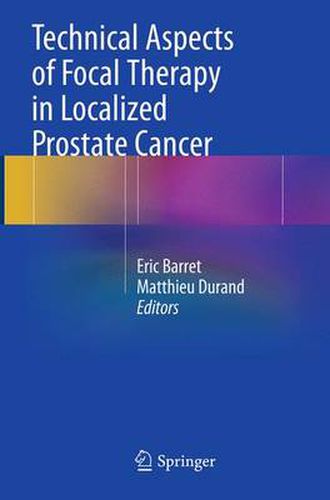Readings Newsletter
Become a Readings Member to make your shopping experience even easier.
Sign in or sign up for free!
You’re not far away from qualifying for FREE standard shipping within Australia
You’ve qualified for FREE standard shipping within Australia
The cart is loading…






Focal therapy is a promising option for selected patients who have localized low or intermediate-risk prostate cancer, providing a compelling alternative between active surveillance and radical therapies by targeting the index lesion and preserving as much tissue as possible. Numerous cohort studies have already investigated multiple focal techniques, such as cryotherapy, high-intensity focused ultrasound, brachytherapy, photodynamic therapy, laser therapy, irreversible electroporation and cyberknife methods, all of which have demonstrated positive oncological outcomes with 70 to 90 % negative follow-up biopsy.
These various ablative techniques have produced only minor side-effects concerning urinary function, a low rate of erectile dysfunction, and have demonstrated a limited rectal toxicity.
As a result, the primary end-point has now shifted and a new strategy needs to be established for patient follow-up and for defining treatment failure.
Written by international experts in the field, this book is mainly focused on new techniques, all of which are amply illustrated. Technical Aspects of Focal Therapy in Localized Prostate Cancer will be of great practical value to all urologists and oncologists.
$9.00 standard shipping within Australia
FREE standard shipping within Australia for orders over $100.00
Express & International shipping calculated at checkout
Focal therapy is a promising option for selected patients who have localized low or intermediate-risk prostate cancer, providing a compelling alternative between active surveillance and radical therapies by targeting the index lesion and preserving as much tissue as possible. Numerous cohort studies have already investigated multiple focal techniques, such as cryotherapy, high-intensity focused ultrasound, brachytherapy, photodynamic therapy, laser therapy, irreversible electroporation and cyberknife methods, all of which have demonstrated positive oncological outcomes with 70 to 90 % negative follow-up biopsy.
These various ablative techniques have produced only minor side-effects concerning urinary function, a low rate of erectile dysfunction, and have demonstrated a limited rectal toxicity.
As a result, the primary end-point has now shifted and a new strategy needs to be established for patient follow-up and for defining treatment failure.
Written by international experts in the field, this book is mainly focused on new techniques, all of which are amply illustrated. Technical Aspects of Focal Therapy in Localized Prostate Cancer will be of great practical value to all urologists and oncologists.